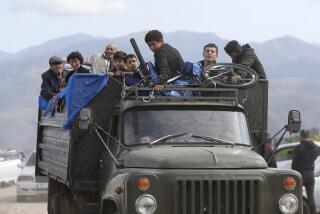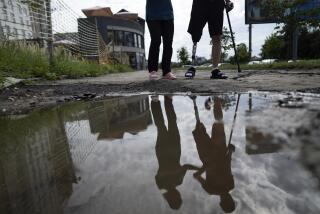Nurse Pursues Her Mission of Mercy, Hope in Armenia
- Share via
It is midnight in a dingy hospital in Yerevan, in the tiny republic of Soviet Armenia, and Dotty Manning has been working for eight hours, carefully changing the dressings of patients paralyzed in the devastating earthquake of Dec. 7, 1988.
It is a long way from Manning’s Huntington Beach home, but the 54-year-old nurse doesn’t seem to mind. She is going on her seventh month in the first modern spinal-injury unit in this southern Soviet republic and she says it’s the most worthwhile job she has ever had.
“My mother was scared to death for me to come to Russia. Most of the community thinks I’ve really slipped a cog,” Manning said. “But when this chance came, I thought, ‘Well, are you going to worry about how old you are and how long it’s been? Or are you going to jump off into the unknown?’ I jumped, and I wouldn’t trade this experience for anything.”
Manning is part of an International Red Cross team of 23 nurses, doctors and physiotherapists from the United States and Europe who have been working at the Institute of Physiotherapy of Yerevan since January, 1989. They treat spinal-cord injuries with Western techniques unknown to the medical community here. Since September, they have been training Armenian medical staffers to care for the patients themselves.
As if their working conditions weren’t difficult enough, Yerevan has been rocked in recent weeks by the ancient battles of Azerbaijanis and Armenians. In mid-January the city became a staging area for civilians dressed in old army uniforms and armed with rifles who boarded buses for the frontier with the neighboring republic of Azerbaijan.
Fighting along the border pitted Azerbaijanis, most of whom are Muslim, against Armenians, most of whom are Christian. Battles also flared in Nagorno-Karabakh, an enclave of Armenians inside Azerbaijan. In the Azerbaijani capital of Baku, three days of anti-Armenian pogroms in January led Soviet troops to open fire on rioters and impose a state of emergency in the city.
Doctors and nurses at the Institute of Physiotherapy of Yerevan, however, concentrated on the 50 or so patients with spinal-cord injuries, which left most of them partially paralyzed. They are victims of the earthquake which took more than 25,000 lives when it slammed the mountains of Armenia more than a year ago. Under the care of Manning and the other members of the Red Cross, the victims are learning to live as disabled people in a society with little understanding of their needs.
“Armenians see the patients as sick, with a capital S,” Manning said. “We in the West don’t see them as acutely ill. They have had a drastic change in their lives, yes. They are paralyzed, yes, but they are not sick. Here, they stay in the hospital for a very long time, and then they go home and they are hidden away until they die.”
To change the way patients feel about themselves and the treatment they receive--at least at this hospital--Manning and her colleagues work in shifts 24 hours a day, teaching patients to care for themselves and strengthen their limbs.
The cramped room where the team is based is an oasis of Western medicine in a hospital where modern amenities were severly lacking. On the walls hang charts and diagrams of the human spine, neuroanatomy and vertebral columns. There are maps of Yerevan, carefully arranged file folders and textbooks on spinal-cord injuries.
Outside the office the wooden floors are dusty, the lighting is poor and the bathrooms are covered with dirt.
The Red Cross team brought thousands of dollars in supplies from the West: bandages to dress wounds; shelving for storage; wheelchairs and equipment for physical therapy. Patients move around the hospital and its grounds on ramps provided by Red Cross money, and they exercise on outdoor playground equipment brought in by the team.
But Manning and others said the most important import the team brought to Armenia is the belief that disabled patients do not have to spend the rest of their lives in bed.
“Even if we give them the best care available, to send someone out to Spitak in a wheelchair and expect them to survive is not going to be realistic,” said Dr. Vernon Hill, director of the spinal-injuries unit. “We need this to be the catalyst to get these people treated here in the way we feel is required.”
The team has been training 15 Armenian nurses and several doctors at the hospital, teaching them to manage patients’ time by scheduling their physical therapy sessions and treatment. Until the Red Cross came to Armenia, paralyzed patients were treated with massage, hot mud packs and electrical stimulation--techniques abandoned in the United States 30 years ago.
Kidney failure is the biggest killer of spine-injured patients, Hill said. The Red Cross team spends much of its time teaching patients to insert catheters to regulate their urine flow and training nurses to insert and remove catheters and inspect patients for signs of infection.
The nurses also turn the patients in their beds regularly, preventing painful bedsores. Manning said that before the Red Cross team came, a number of the patients had numerous bedsores. Now, she said, most of the sores have healed.
Before, patients were on their own after 5 p.m. when the nurses went home. Now, they are cared for by nurses around the clock.
There are no facilities for the handicapped in Armenia, or in much of the Soviet Union, Hill said. Sidewalks have high curbs and are pockmarked with holes. Most people live in apartments without elevators and ramps are virtually unknown.
Last summer, the team began to take patients to sporting events, concerts and plays, getting them used to seeing and being seen on Yerevan streets.
“I’ll never forget the scene the first time we took them to a soccer stadium,” Manning said. “You could just feel the reaction. There were 10 patients in wheelchairs pushing themselves along. The astonishment was palpable.”
Manning had been helping people with spinal-cord injuries at a rehabilitation unit in Anaheim when friends told her the Red Cross was looking for specialists to work in Soviet Armenia. For her, the journey to this republic was the latest stop in an odyssey of self-discovery.
As a 24-year-old nursing student in 1959, Manning left her Miami home to work in the Albert Schweitzer Hospital in Des Chapelles, Haiti. In the years after her return, she married and settled into a life of being a nurse and homemaker.
When the chance to go to Armenia came, “The question was, could I be effective again with gray hair?” Manning asked. “But I wouldn’t trade this experience for anything. The Armenian people are wonderful. They take you into their homes, into their hearts.”
In addition to hospital duties, team members travel to patients’ homes, which are often prefabricated, boxcar-like metal shacks. The medical team lives in a Yerevan hotel, often without hot water or heat. And, like the rest of the more than 200,000 people in the polluted Armenian capital, they wrestle every day with simple survival--fighting the long lines for food, the stores with shelves that are often bare and the inadequate phone system.
On a recent day in the hospital, Manning was there to watch one of her patients get out of bed for the first time since he was trapped in his Leninakan factory by rubble that fell in the temblor.
The patient, Sergik Merkosian, 31, lost the use of his legs in the disaster. But on this morning, with arms strong from exercise prescribed by the Red Cross team, he pulled himself into a padded wheelchair designed especially for him. He sat up for five minutes, before going back to bed.
“It is because of them that my arms are so strong,” Merkosian said. “I think it is much more than simply curing. They have tried to make my life lighter and to help me forget everything that happened to me--the fact that I am a man in bed.”
The program is only the beginning of Red Cross plans to treat Armenia’s disabled patients. The International Red Cross is planning a Post-Traumatic Rehabilitation Center in Yerevan, expected to be completed by the end of 1991. The organization also plans to send several Armenian doctors for medical training in the West.
“We are trying to give them the facilities to teach what is possible,” said Encho Gospodinov, a Red Cross spokesman in Yerevan. “In the beginning, when they learned a medical team was coming from the West, they expected miracles to happen. They were a bit disappointed. Most of them will stay in wheelchairs. But we are teaching them and society here that, even so, they can be independent for the rest of their lives.”
More to Read
Sign up for Essential California
The most important California stories and recommendations in your inbox every morning.
You may occasionally receive promotional content from the Los Angeles Times.










